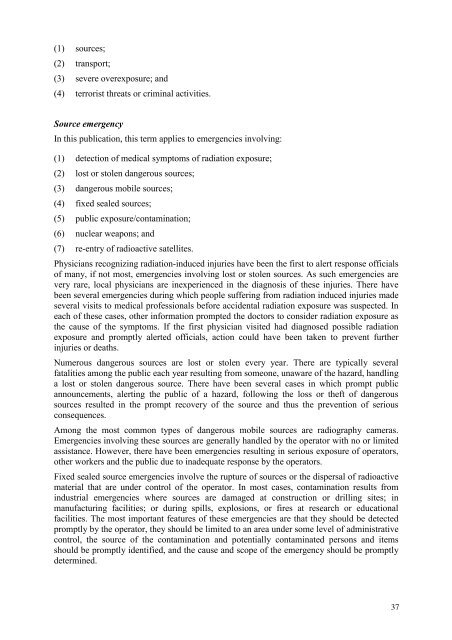epr-method (2003) - IAEA Publications - International Atomic Energy ...
epr-method (2003) - IAEA Publications - International Atomic Energy ...
epr-method (2003) - IAEA Publications - International Atomic Energy ...
You also want an ePaper? Increase the reach of your titles
YUMPU automatically turns print PDFs into web optimized ePapers that Google loves.
(1) sources;<br />
(2) transport;<br />
(3) severe overexposure; and<br />
(4) terrorist threats or criminal activities.<br />
Source emergency<br />
In this publication, this term applies to emergencies involving:<br />
(1) detection of medical symptoms of radiation exposure;<br />
(2) lost or stolen dangerous sources;<br />
(3) dangerous mobile sources;<br />
(4) fixed sealed sources;<br />
(5) public exposure/contamination;<br />
(6) nuclear weapons; and<br />
(7) re-entry of radioactive satellites.<br />
Physicians recognizing radiation-induced injuries have been the first to alert response officials<br />
of many, if not most, emergencies involving lost or stolen sources. As such emergencies are<br />
very rare, local physicians are inexperienced in the diagnosis of these injuries. There have<br />
been several emergencies during which people suffering from radiation induced injuries made<br />
several visits to medical professionals before accidental radiation exposure was suspected. In<br />
each of these cases, other information prompted the doctors to consider radiation exposure as<br />
the cause of the symptoms. If the first physician visited had diagnosed possible radiation<br />
exposure and promptly alerted officials, action could have been taken to prevent further<br />
injuries or deaths.<br />
Numerous dangerous sources are lost or stolen every year. There are typically several<br />
fatalities among the public each year resulting from someone, unaware of the hazard, handling<br />
a lost or stolen dangerous source. There have been several cases in which prompt public<br />
announcements, alerting the public of a hazard, following the loss or theft of dangerous<br />
sources resulted in the prompt recovery of the source and thus the prevention of serious<br />
consequences.<br />
Among the most common types of dangerous mobile sources are radiography cameras.<br />
Emergencies involving these sources are generally handled by the operator with no or limited<br />
assistance. However, there have been emergencies resulting in serious exposure of operators,<br />
other workers and the public due to inadequate response by the operators.<br />
Fixed sealed source emergencies involve the rupture of sources or the dispersal of radioactive<br />
material that are under control of the operator. In most cases, contamination results from<br />
industrial emergencies where sources are damaged at construction or drilling sites; in<br />
manufacturing facilities; or during spills, explosions, or fires at research or educational<br />
facilities. The most important features of these emergencies are that they should be detected<br />
promptly by the operator, they should be limited to an area under some level of administrative<br />
control, the source of the contamination and potentially contaminated persons and items<br />
should be promptly identified, and the cause and scope of the emergency should be promptly<br />
determined.<br />
37

















